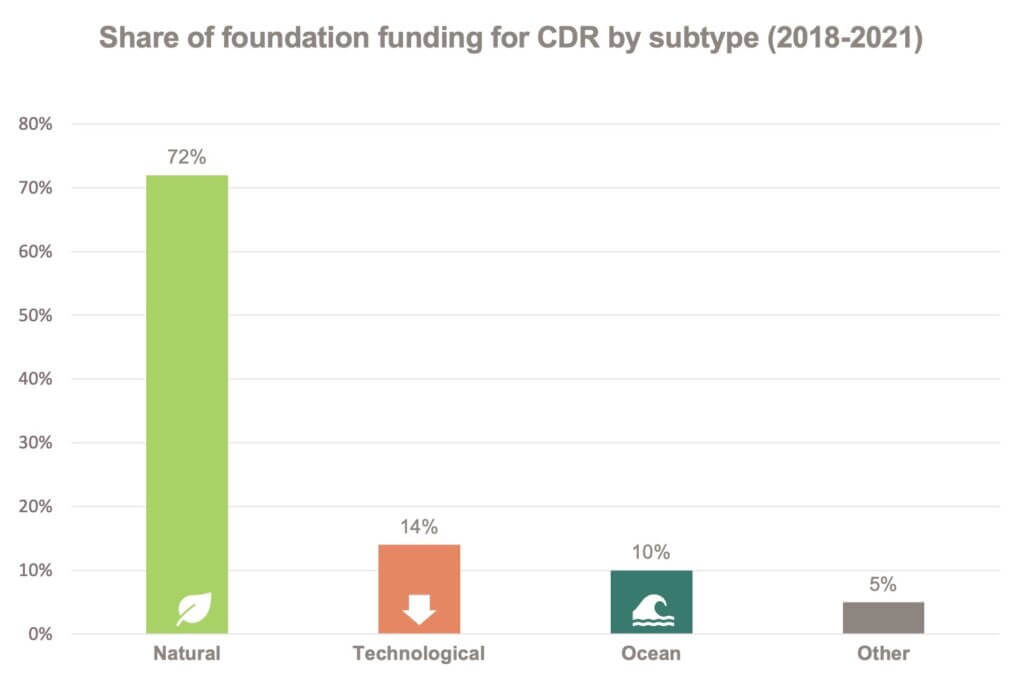
The United Nations earlier this week made the very distressing announcement that global temperatures are likely to breach the Paris 1.5 degree Celsius mark in the next five years. Addressing this climate code red requires achieving below-zero net emissions by removing historic carbon dioxide emissions from the atmosphere. Those emissions must be locked away for hundreds if not thousands of years in order for the climate to stabilize. The Intergovernmental Panel on Climate Change and the National Academies estimate that we need about 10 gigatons of carbon dioxide removal (CDR) per year by 2050 to reach net-zero emissions.
To help meet this massive challenge, philanthropy can catalyze change in the climate movement and help scale the CDR field in a significant way. ClimateWorks Foundation’s report Funding trends 2022: Climate change mitigation philanthropy highlighted various gaps in funding for different CDR solutions. Looking ahead, there is a significant opportunity for an improved funding strategy for the CDR field.
Significant momentum for land-based carbon removal solutions
Forests, soils, and oceans have each naturally removed about one-third of human-caused climate pollution. There are various ways to harness the carbon removal potential of these natural resources through methods like planting trees or restoring peat bogs.
Climate philanthropy has supported powerful land-based removal solutions for years. In 2018, the amount of philanthropic funding for carbon removal was $80 million per year. ClimateWorks’ research on funding trends in climate change mitigation philanthropy found that the number had nearly doubled between 2021 and January 2023, reaching $175 million. The majority of this funding from 2018 to 2021 went to natural removal solutions such as reforestation, biochar, peat rewetting, and soil carbon solutions.
This philanthropic support is already beginning to pay off. Natural solutions are removing about two gigatons per year of carbon dioxide from the atmosphere, according to a recent Oxford University report. These natural solutions are very low cost — around just $10 per ton of carbon dioxide removed, according to the National Academies — and they are ready to deploy today.
However, natural solutions alone cannot meet the challenge of removing legacy emissions for several reasons. First, relying entirely on natural solutions requires an enormous amount of land currently used for growing food and supporting the livelihoods of Indigenous groups. Additionally, trees, soil, and plants store carbon dioxide when they are alive and growing but then release that carbon dioxide back into the atmosphere. As the climate warms, increasing fire, flood, drought, and pests can kill trees and plants, releasing the carbon dioxide they have been storing. This “reversible” nature of trees and plants means that every new generation has to start the removal process over again.

More funding for technological solutions could be the key to success
To supplement the role of natural carbon dioxide sinks and to spare land, technological solutions that can mimic these natural processes are needed. But technological solutions are still in the early stages of research. As a result, much more work is required to deploy technological solutions at scale, including the evaluation of challenges associated with implementation and bringing down costs. One such technological solution is direct air capture (DAC), which involves harnessing zero-carbon renewables and geothermal heat to suck carbon out of the atmosphere. Another is mineralization, which helps rocks to absorb and store carbon — by heating them or by turning over mine tailings more frequently, for example. Weatherization speeds up the erosion of rocks near water and can help to neutralize climate-caused ocean acidification. However, according to a 2023 Oxford University-led study, technological solutions only comprise .002% of carbon removal solutions deployed today. To keep temperatures below a 1.5° C increase, we’ll need to scale technological solutions by a factor of 1,300 by 2050.
Without government support to spur new research and innovation and flexible philanthropic funding, these technological solutions will not be available at the pace needed to meet future carbon removal challenges. In terms of philanthropy, about 72% of all funding for carbon dioxide removal since 2018 has gone toward efforts to scale natural removal. In contrast, technological removal received only about 14% of cumulative funding.
More funding for research on ocean carbon dioxide removal is a crucial next step
Ocean carbon dioxide removal is another category of solutions that warrants further exploration. As land-based approaches remove carbon, the oceans will release some of the excess carbon they have been storing back into the atmosphere. Accordingly, it is imperative to better understand the role oceans play in helping the climate. To date, however, there is virtually no scientific literature on ocean carbon dioxide removal, according to a recent National Academies study.
Between 2018 and 2021, philanthropic funding for ocean carbon dioxide removal research represented just 10% of all removal spending. Nonetheless, public, private, and philanthropic sector ambition around ocean removal is starting to grow — in part due to studies such as the recent ClimateWorks-sponsored National Academies effort on ocean removal. In 2022, the Biden administration and Congress committed $60 million to better understand the ability of oceans to remove and store carbon dioxide. While this commitment is promising, it represents only a fraction of the National Academies’ projection of at least $10 billion needed to truly understand how to better help oceans combat global climate change through CDR.
Early returns for philanthropic funds supporting CDR
Philanthropy can spur critical early research, support new exploration, convene relevant partners, and help catalyze additional investments to generate the research and development pipeline needed to truly implement carbon dioxide removal at scale. Already, there are compelling examples of what early philanthropic support to the field has been able to achieve:
- Realizing the need to support early work in carbon dioxide removal, ClimateWorks Foundation has played a vital role since 2018 in catalyzing research to support ambitions for CDR. Even with a small grant budget of just $12 million per year dedicated to CDR, we were able to catalyze nearly $10 billion in public and private funding for land-sparing solutions. This includes $3.5 billion in bipartisan infrastructure law funding for four DAC hubs around the United States.
- Using zero carbon aviation fuel rather than oil to scale direct air capture requires green hydrogen as a resource. In addition to DAC hubs, the Bipartisan Infrastructure Bill enacted in 2021 provides $7 billion to establish 10 U.S. hydrogen hubs. Using removed carbon and green hydrogen to power aviation has the added advantage of eliminating particle pollution from airports and airport-adjacent communities.
- In addition to the DAC and hydrogen hubs, the Department of Energy created the Carbon Negative shot, an effort to reduce the cost of technological solutions to $100 per ton, a level that makes them more feasible to scale.
- The 45Q tax credit of 2018 that ClimateWorks grantees helped to enshrine led to $912 million in new investments, according to Bloomberg New Energy Finance (BNEF). More recent bipartisan Inflation Reduction Act refinements to the 45Q tax credits grantees helped enshrine could deliver up to $100 billion in new investments.
- An early philanthropic grant to the World Resources Institute for a direct air capture buyers club that eventually culminated in the new $1 billion Frontier Fund co-sponsored by companies such as Thistledown, Stripe, and Meta.
- In addition to spurring public and private carbon removal funding, ClimateWorks has worked with other philanthropic funders and their boards to mobilize nearly $154 million in new philanthropic dollars for carbon removal.
- ClimateWorks’ justice-focused grants total more than $8 million and are targeted at communities where the Biden administration monies aim to co-fund carbon removal hubs, which can help to transition workers from oil industry jobs.
The work ahead
It is worth celebrating the current momentum for carbon dioxide removal efforts — notably, the federal ambition and momentum for private funding in the United States. However, there is much more work for the climate philanthropy community to do. Achieving the Paris Agreement’s target of net-zero emissions by 2050 will require scaling technological solutions by a factor of 1,300. Despite important strides in recent years, climate philanthropy needs to further ramp up its efforts to accelerate technological solutions.
To scale technological solutions, climate philanthropy must aim to replicate the successes of efforts to accelerate the adoption of solar energy. Around 30 years ago, a few visionary funders including the Energy Foundation in the United States, the European Climate Foundation, and the Energy Foundation in China funded grantees to advocate for state standards to drive the use of renewable energy, some beginning this work about 30 years ago. Together, these funders created the policy conditions to scale solar such that it outcompetes coal today. With less than 30 years left until the 2050 net-zero target, climate philanthropy needs to bring the same discipline, strategies, and resources to the task of land-sparing carbon dioxide removal. Without immediate action, frontline communities and future generations could pay a heavy cost.



